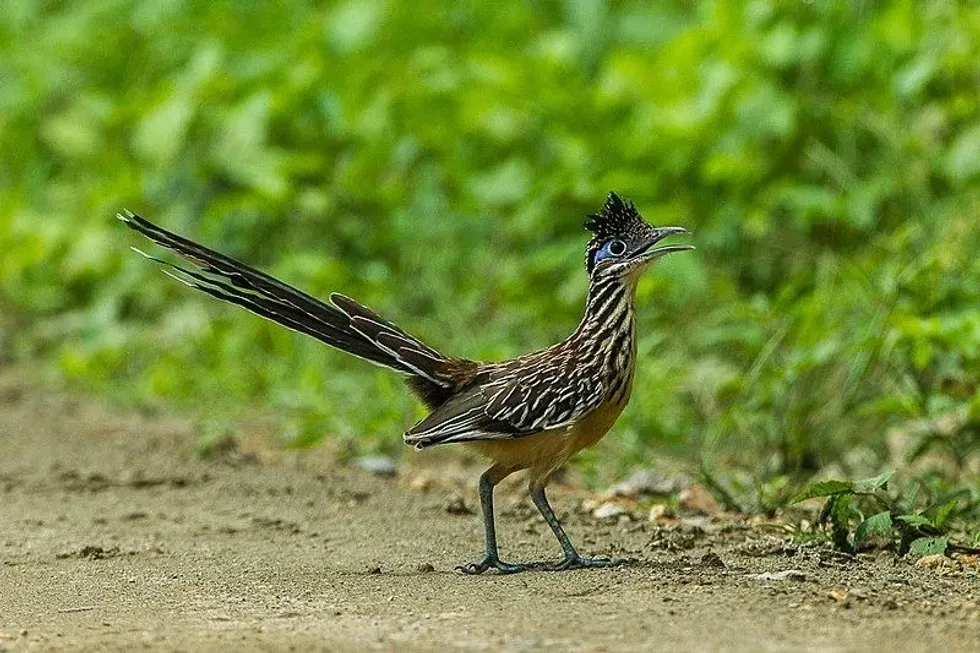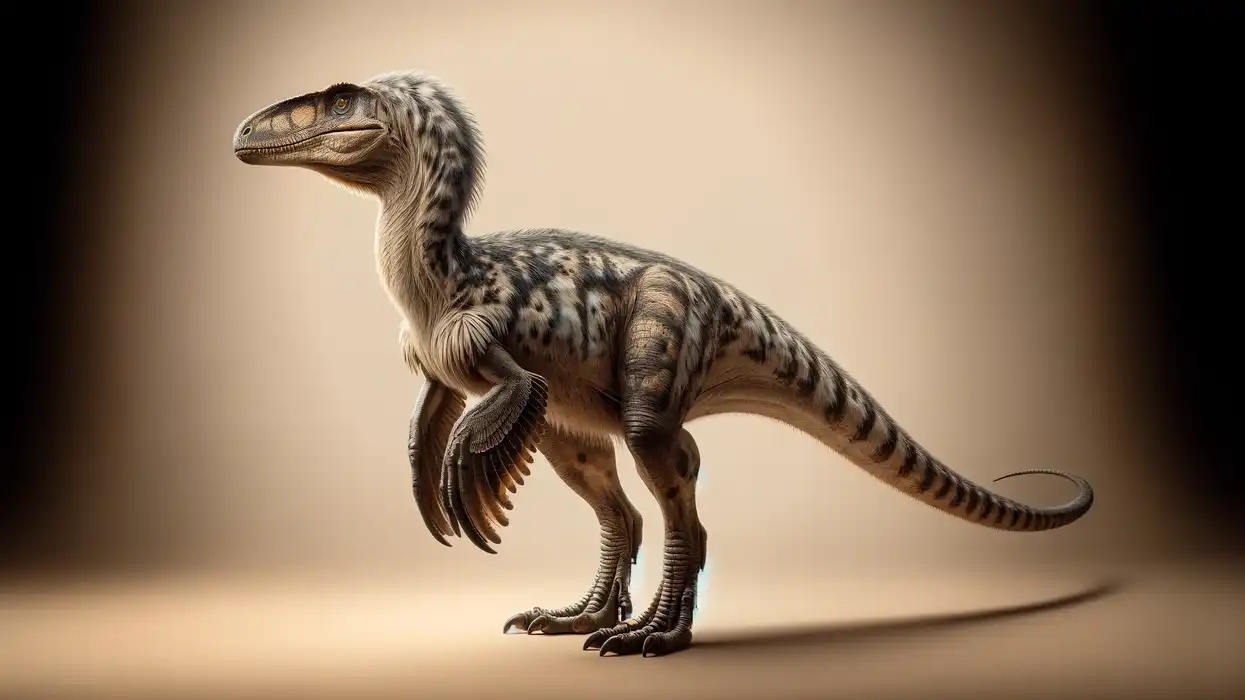The lesser roadrunner (Geococcyx velox) is a bird of the cuckoo family, native to Mexico and Central America. Lesser and greater roadrunners are the only two members of the genus Geococcyx. Both these birds are known for their running speeds.
Lesser roadrunners are easily identifiable by their black crown, neck, and crest, with brown spots. They also have streaks on their throat and chest.
These birds are not very strong fliers and are terrestrial in nature. Some of their common prey and foods are grasshoppers, snakes, frogs, and seeds.
Since they have such great speed, they are also capable of preying on rattlesnakes. These birds live in dry and arid regions and hence, they manage to fulfill their water requirements from the moisture in the tissue and blood of their prey.
Lesser roadrunners are found quite commonly in their natural range and they do not face any immediate threats of endangerment. However, they are susceptible to a declining population as their habitat is becoming fragmented.
To learn some amazing lesser roadrunner bird facts, keep reading! If you like this article, you can also check out our facts about the mockingbird and Fischer's lovebird!
Lesser Roadrunner Interesting Facts
What type of animal is a lesser roadrunner?
The lesser roadrunner (Geococcyx velox) is a kind of bird. These birds are one of the two species under the genus Geococcyx and are found in Mexico and Central America.
What class of animal does a lesser roadrunner belong to?
Lesser roadrunners belong to the class Aves. They are part of the Cuculidae family (also known as the cuckoo family), which also accounts for several other species of bird.
How many lesser roadrunners are there in the world?
According to the International Union for Conservation of Nature (IUCN), the lesser roadrunner species has a stable population in the wild. The lesser roadrunner distribution is quite widespread in its natural range and the number of mature birds in the wild is estimated to be between 500,000-4,999,999.
Where does a lesser roadrunner live?
The lesser roadrunner range covers parts of Mexico and Central America. These G. velox birds can be found in the western part of the Sierra Madre Occidental range, in southwestern Mexico, and in the northern part of Central America. A disjunct range of these birds, meaning a geographically separated population, occurs to the north of the Yucatán Peninsula.
What is a lesser roadrunner's habitat?
The lesser roadrunner's habitat mainly consists of shrublands with scrubs and thorny vegetation. They can also occupy fields where cultivation is carried out. An arid climate characterizes the natural habitat of these birds.
Who do lesser roadrunners live with?
The lesser roadrunner species is mostly seen alone or in pairs. Juvenile lesser roadrunners are known to stay with their parent birds for a week or two after they hatch out of their eggs.
How long does a lesser roadrunner live?
The lesser roadrunner is known to live for seven to eight years.
How do they reproduce?
The breeding season for lesser roadrunners is from April to July in Mexico and in August in El Salvador. These birds form monogamous pairs and build their nest on a thorn bush or any low tree.
The nest has a diameter of about 5.7 in (14.4 cm), where the female bird lays between two and four eggs. Both parents incubate the eggs until their offspring hatch out.
What is their conservation status?
The conservation status of the lesser roadrunner bird (Geococcyx velox) has been marked as Least Concern by the International Union for Conservation of Nature (IUCN). Lesser roadrunners do not face any immediate threat, however, they can fall prey to road accidents and illegal hunting. Habitat loss can also lead to a decline in the population of these birds.
Lesser Roadrunner Fun Facts
What do lesser roadrunners look like?
The crown, neck, and crest in the lesser roadrunner species are black in color with small and light brown spots. They have streaks on their throat and chest. The outer wings and rump appear brownish, while their underside is yellowish-white.
The tail feathers are brown, black, or white. They have a short bill and blue or pale lavender eye-ring. Like other members of the cuckoo family, lesser roadrunners also have zygodactyl feet, signified by two toes on the back and two toes on the front.
How cute are they?
Lesser roadrunners are quite cute in appearance. The running speed of these birds further adds to their appeal.
How do they communicate?
This bird species is mainly known to communicate through calls and vocalizations. They can be heard making 'cooing' sounds on a descending scale.
How big is a lesser roadrunner?
The length of a lesser roadrunner is usually between 18.1-20 in (46-51 cm), with 18 in (45.7 cm) being the average length. The average lesser roadrunner size is considerably smaller than the average greater roadrunner size which is between 19.6-24.4 in (49.7-62 cm).
Can a lesser roadrunner fly?
The lesser roadrunner can fly but is not very adept at doing so, just like the other member of its genus. They are known for their running speed, which can be up to 20 mph (32.1 kph), similar to a cardinal bird.
How much does a lesser roadrunner weigh?
The weight of a lesser roadrunner is between 6.1-7.3 oz (173-207 g) for males and 5.7-6.7 oz (162-190 g) for females.
What are the male and female names of the species?
This species' male and female birds are known as male lesser roadrunners and female lesser roadrunners.
What would you call a baby lesser roadrunner?
A baby lesser roadrunner is known as a juvenile lesser roadrunner or a chick.
What do they eat?
Lesser roadrunners (Geococcyx velox) have an omnivorous diet, feeding majorly on grasshoppers and caterpillars. They also eat other kinds of insects, frogs, snakes, other birds, and small mammals. The plant materials in their diet include fruits and seeds. These birds also eat roadkill.
Are they dangerous?
The birds of this species are highly territorial in nature and can become aggressive in order to protect their territory. Other than that, they aren't known to pose a threat to humans. The same applies to the greater roadrunner species as well.
Would they make a good pet?
Lesser roadrunners (Geococcyx velox) are a wild bird species and they would not be suitable as pets.
Did you know...
Lesser roadrunner birds are often seen basking in the sun while sitting on a fence post. They use their black feathers to absorb the heat from the sun. These birds are also capable of lowering their body temperature during cold nights.
Lesser roadrunner vs. greater roadrunner
The lesser and greater roadrunner are two different species under the genus Geococcyx. The main difference between the greater and lesser roadrunner lies in their appearance. The lesser roadrunner is much smaller, buffier, and has a shorter bill in comparison to greater roadrunners. Their chest and throat regions are not as streaked, either.
The breeding range varies for both species. For lesser roadrunners, their range includes parts of Mexico and Central America, like the Sierra Madre Occidental range and the Yucatán Peninsula, but greater roadrunners are found in the southwestern United States and northern parts of Mexico.
Do roadrunners drink water?
Roadrunners do drink water when it is available. However, given the kind of arid habitats they live in, these birds rely on the moisture from the tissues and blood of their prey to meet their water requirements most of the time.
Here at Kidadl, we have carefully created lots of interesting family-friendly animal facts for everyone to discover! For more relatable content, check out these lyrebird facts and mountain bluebird facts for kids.
You can even occupy yourself at home by coloring in one of our free printable lesser roadrunner coloring pages.









